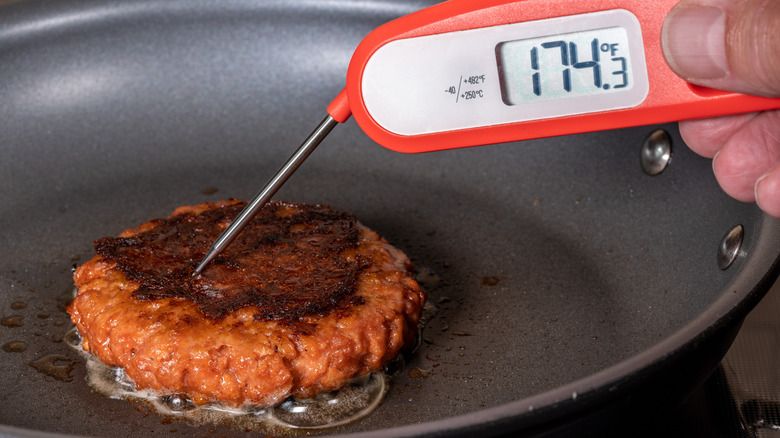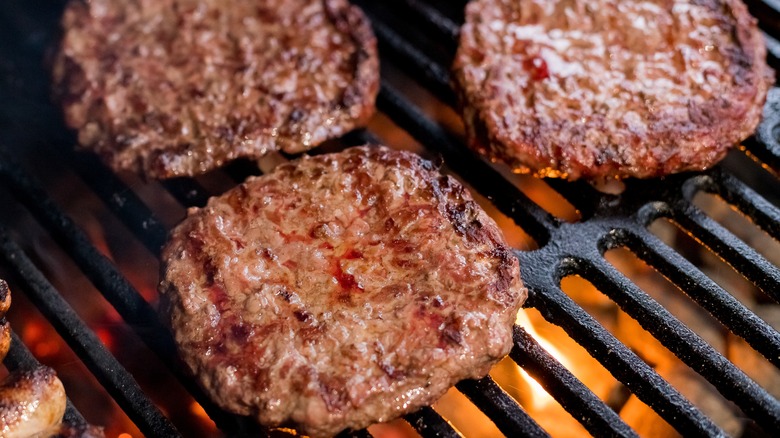A Rare Steak Is Safer To Eat Than A Rare Burger. Here's Why
Before humans discovered how to make fire, they ate all their food raw, including meat. Since raw meat may harbor bacteria such as E. coli and salmonella, many prehistoric humans fell ill from doing so. It's now been roughly 800,000 years since humans first began cooking their meat prior to eating it. Yet hundreds of thousands still fall ill each year as a result of foodborne illness — with a significant, albeit unquoted, number from eating raw or undercooked meat, in particular.
When we say "undercooked," we mean meat that hasn't been cooked to a high enough temperature to kill the harmful bacteria it may harbor. That temperature will vary, depending on the meat and whether it is ground versus a whole cut, but in the case of beef, it's always going to be a minimum of 145 degrees Fahrenheit. That's the temperature at which steak is warm and pink at its center (i.e., medium).
Nevertheless, many people enjoy their steak served rare. Fortunately for rare meat aficionados, the risk of foodborne illness associated with rare steak is relatively low, but the same cannot be said with respect to rare burgers. There are two main reasons why a rare steak is safer to eat than a rare burger. The first comes down to the surface area of the respective types of meat. The second comes down to the cooking process.
Burgers have a lot more contaminable surface area than steaks
Cross-contamination, which is what happens when meat comes into physical contact with bacteria, can happen at any point during processing — from the moment a cut of meat is sliced from the primal carcass until you toss it onto a searing-hot grill. But cross-contamination occurs only at the surface level of the meat, explains Ted Siegel, a chef and instructor at the Institute of Culinary Education (via Reader's Digest). So, in terms of food safety, the first essential difference between a steak and a burger is the size of the surface area of each type of meat.
Steak has, in essence, just a single surface — i.e., the entire outside surface of the steak. That surface is the only one that stands to become cross-contaminated during processing up until the moment the meat arrives at your lips. A burger, by contrast, has a near-infinite number of surfaces that might have come into physical contact with a foodborne pathogen at some point along the journey.
For one thing, burgers are generally comprised of meat ground from various hunks and trimmings of meat. Any of these may have been exposed to surface contaminants. Moreover, as Siegel explains, grinding up the meat disperses those surface pathogens — if not ubiquitously throughout the meat then certainly deeper than just the exterior. Accordingly, cooking burgers sufficiently to kill harmful bacteria requires a different process from that which is considered effective for steak.
Cooking meat sufficiently depends on the meat, itself
With few exceptions, neither E. coli nor salmonella bacteria can survive exposure to temperatures in excess of 160 degrees Fahrenheit. At that internal temperature, beef is considered well done. However, as the Institute of Culinary Education's Ted Siegel notes, cross-contamination occurs primarily at the meat's surface.
Accordingly, for steaks, only the surface of the beef needs to be exposed to temperatures of 160 degrees Fahrenheit. That can be accomplished simply by searing the steak on a grill heated to anywhere between 300 and 500 degrees Fahrenheit. By the time you remove your steak from the grill, its exterior will have reached well over 160 degrees although the interior temperature will be about 125 degrees on a rare-done steak. In this way, your steak can be cooked rare, but likely still free of bacteria. It should be noted that the USDA recommends that all steaks be cooked to an internal temperature of at least 145 degrees Fahrenheit, which results in a medium-done steak.
Burgers are a different story, though because burgers are made of ground beef and the grinding process spreads "surface" bacteria throughout the meat. Accordingly, cooking the exterior surface of a burger to 160 degrees Fahrenheit cannot and will not address any bacteria that may have been dispersed into the interior of the patty. Because a rare burger isn't cooked beyond an internal temperature of 125 degrees Fahrenheit that puts the eater at risk. In fact, even a burger cooked to medium well doesn't get above 150 degrees Fahrenheit. In other words, because burgers are made from ground beef, only cooking them to an internal temperature of 160 degrees Fahrenheit or well done, will do (at least in terms of food safety). So if you like your meat rare, the safer option is to opt for a steak.


